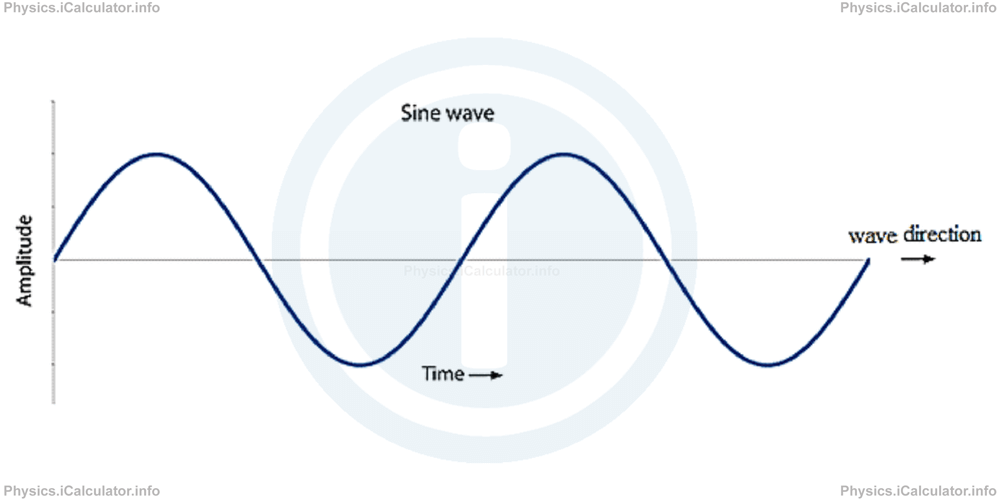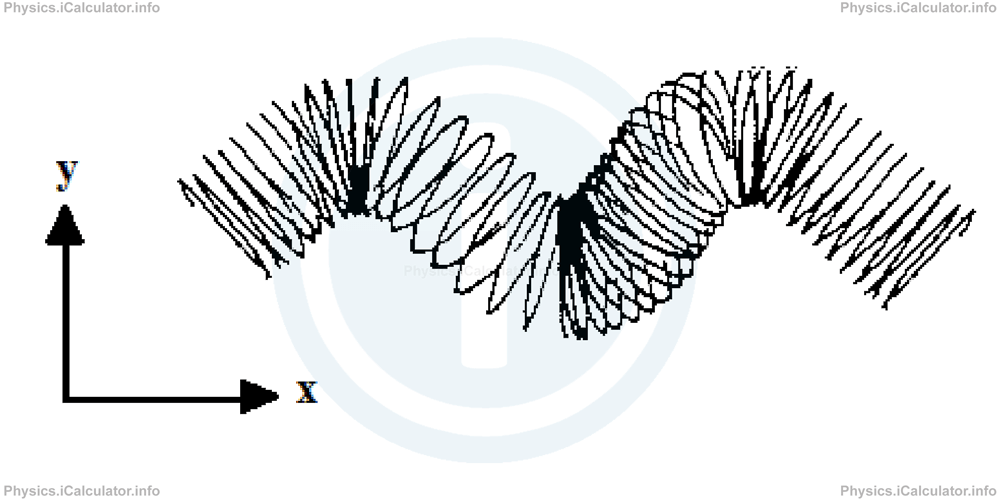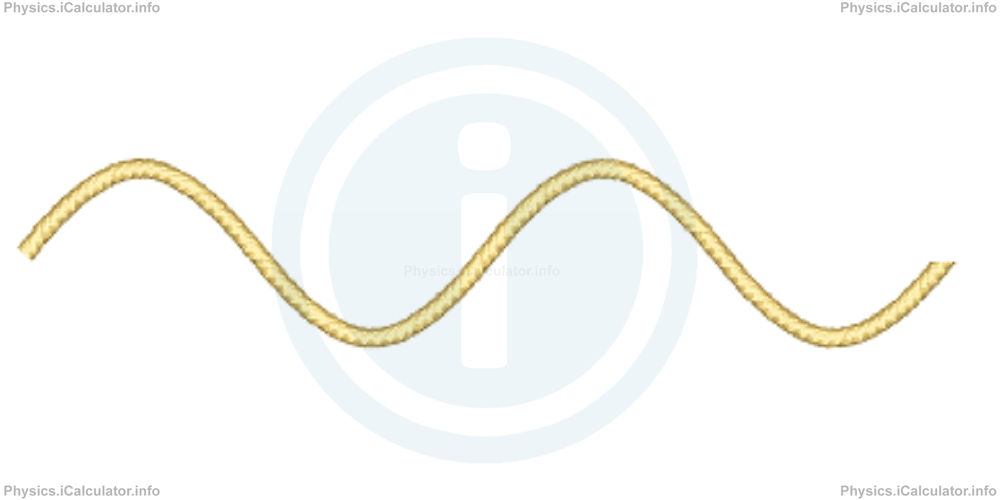Menu
Physics Lesson 11.3.1 - Energy in Waves
Please provide a rating, it takes seconds and helps us to keep this resource free for all to use
Welcome to our Physics lesson on Energy in Waves, this is the first lesson of our suite of physics lessons covering the topic of Energy and Power of Waves, you can find links to the other lessons within this tutorial and access additional physics learning resources below this lesson.
Energy in Waves
As stated in the previous tutorials, waves do not carry matter but only energy. This is because in all waves (although this is more visible in transverse waves) a particle oscillates around an equilibrium position giving a zero resultant displacement, while the wave spreads in a certain direction. Look at the figure:

Energy of waves depends on two factors: amplitude and frequency. This is because when a particle of a wave as the one shown in the above figure oscillates up and down, its gravitational potential energy depends on the amplitude, i.e. how far it displaces from the equilibrium position. Therefore, a greater amplitude means a greater gravitational potential energy for this particle when it reaches the maximum position.
On the other hand, it is a known fact that kinetic energy depends on the moving speed (KE = m × v2 / 2) and the latter depends on the wave frequency if wavelength is taken as constant (v = λ × f=>v ~ f for constant λ).
For example, the strength of seismic waves, which cause up and down oscillations of the Earth surface during earthquakes, depends on the amplitude of oscillations. Stronger the earthquake, greater the amplitude of seismic waves. On the other hand, the energy of EM waves depends on their frequency. Thus, higher the frequency of EM waves, higher their penetrating ability and therefore, greater the energy such waves carry with them.
Now, let's find a formula for the energy and then for the power of waves based on the actual knowledge on waves and their properties.
Consider an oscillating spring of mass m as shown in the figure.

We chose such a spring as its motion is both a combination of transverse and longitudinal waves, so the study of energy will be more complete.
The string oscillated up and down, so its kinetic energy is
In the previous tutorial, we have shown that the oscillating speed vy of a wave is
= d[A × sin(k × x - ω × t)]/dt
= -A × ω × cos(k × x - ω × t)
Hence, we obtain for the kinetic energy of the oscillating spring:
= m × A2 × ω2 × cos2 (k × x - ω × t)/2
As we know, cosine values vary from -1 to + 1 but when they are raised in power two, they become always positive. Hence, they vary from 0 to 1. This means the average value of all cosines at power two is 1/2. Therefore, we obtain for the kinetic energy of spring:
= m × A2 × ω2/4
Also, we know that the potential energy PE of an oscillating spring is calculated by the equation
and giving that
we obtain for the potential energy of spring:
= k × A2 × sin2 (k × x - ω × t)/2
In the tutorial "Simple Harmonic Motion", we have explained that the relationship between spring constant k, mass m and angular frequency ω is
Thus,
Substituting this value of k in the equation of potential energy, we obtain
Like in the cosine function, the square of sine function is equal to 1/2 as well. Remember the fundamental equation of trigonometry
This means each of terms is equal to 1/2 because 1/2 + 1/2 = 1. Therefore, we have
= m × A2 × ω2/4
This is the same result as the result obtained for kinetic energy. Hence, we can write for the total (mechanical) energy of the oscillating spring (here we have a spring but this approach can be applied in all situations involving waves):
= KE + PE
= m × A2 × ω2/4 + m × A2 × ω2/4
= 2 × m × A2 × ω2/4
= m × A2 × ω2/2
Example 1
A 150 g rope shakes up and down as shown in the figure.

If the amplitude of wave caused by the shaking process is 20 cm and the up and down movement of the person who shakes the rope occurs every 2 seconds, what is the energy delivered by the rope's wave?
Solution 1
Clues:
m = 150 g = 0.150 kg
A = 20 cm = 0.20 m
f = 1 oscillation / 2 s = 0.5 oscillation/ second = 0.5 Hz
E = ?
First, let's calculate the angular frequency ω. Thus, giving that
we obtain
= 3.14 rad/s
Now, let's apply the formula of wave's energy. Thus,
= 0.150 × 0.202 × 3.142/2
= 0.0296 J
As expected, the energy delivered by such a wave is small. Otherwise, we would use shaking ropes as a source of energy.
You have reached the end of Physics lesson 11.3.1 Energy in Waves. There are 2 lessons in this physics tutorial covering Energy and Power of Waves, you can access all the lessons from this tutorial below.
More Energy and Power of Waves Lessons and Learning Resources
Whats next?
Enjoy the "Energy in Waves" physics lesson? People who liked the "Energy and Power of Waves lesson found the following resources useful:
- Energy Feedback. Helps other - Leave a rating for this energy (see below)
- Waves Physics tutorial: Energy and Power of Waves. Read the Energy and Power of Waves physics tutorial and build your physics knowledge of Waves
- Waves Revision Notes: Energy and Power of Waves. Print the notes so you can revise the key points covered in the physics tutorial for Energy and Power of Waves
- Waves Practice Questions: Energy and Power of Waves. Test and improve your knowledge of Energy and Power of Waves with example questins and answers
- Check your calculations for Waves questions with our excellent Waves calculators which contain full equations and calculations clearly displayed line by line. See the Waves Calculators by iCalculator™ below.
- Continuing learning waves - read our next physics tutorial: Interference of Waves
Help others Learning Physics just like you
Please provide a rating, it takes seconds and helps us to keep this resource free for all to use
We hope you found this Physics lesson "Energy and Power of Waves" useful. If you did it would be great if you could spare the time to rate this physics lesson (simply click on the number of stars that match your assessment of this physics learning aide) and/or share on social media, this helps us identify popular tutorials and calculators and expand our free learning resources to support our users around the world have free access to expand their knowledge of physics and other disciplines.